A review of the major components of home fire sprinkler systems
Residential fire sprinkler systems have a range of components, and the complexity of any given set-up depends on several factors, including if the system is standalone or multipurpose; the water supply to the sprinklers and whether it naturally provides sufficient pressure; the pipe used; and any unique requirements from your local or state government.
In part one of our series covering the installation of home fire sprinklers, we introduced how these systems work, explained the two major types of home systems, and provided guidance on finding a qualified installation contractor. In this piece, we begin to review the major components of residential fire sprinklers, including special considerations that homeowners should be aware of when installing a system.
Are you simply interested in purchasing components for a home sprinkler system? Feel free to jump directly to QRFS’ selection of residential sprinklers or use the search bar at the top of the page.
Different water sources for residential fire sprinklers use different components
The National Fire Protection Association (NFPA) prioritizes saving lives over property in its design and installation standard: NFPA 13D: Standard for the Installation of Sprinkler Systems in One- and Two-Family Dwellings and Manufactured Homes. And to ensure sprinklers give occupants time to escape a fire, NFPA stipulates that systems in most homes must have sufficient water supply to provide at least 10 minutes of coverage at their required pressure and flow. There is an exception, however, for one-story residences under 2,000 square feet, which only need enough water for seven minutes of operation:
From the 2022 edition of NFPA 13D
6.1.1 Every automatic sprinkler system shall have at least one automatic water supply.
6.1.2 Where stored water is used as the sole source of supply, the minimum quantity shall equal the water demand rate times 10 minutes unless permitted otherwise by 6.1.3.
6.1.3 Where stored water is used as the sole source of supply, the minimum quantity shall be permitted to equal the highest calculated water demand rate times 7 minutes where dwelling units meet the following criteria:
(1) One story in height
(2) Less than 2000 ft2 (185 m2) in area
NFPA also outlines five potential sources of water for a residential system, but the choices usually boil down to three major categories: the municipal water supply, a well, or some type of tank that exclusively stores water for the sprinkler system.
From the 2022 edition of NFPA 13D
6.2* Water Supply Sources.
The following water supply sources shall be considered to be acceptable by this standard:
(1) A connection to a reliable waterworks system with or without an automatically operated pump
(2) An elevated tank
(3) A pressure tank designed to American Society of Mechanical Engineers (ASME) standards for a pressure vessel with a reliable pressure source
(4) A stored water source with an automatically operated pump
(5) A well with a pump of sufficient capacity and pressure to meet the sprinkler system demand
One of the first things an installation contractor will do when evaluating an existing residence or new home site is check the pressure of the city water supply (if there is one), as this is the default option to supply a fire sprinkler system. If the water main doesn’t deliver sufficient pressure (about 100 psi is a very safe number), the contractor will have to look at alternate options, whether that involves adding a pump to boost the pressure of the city water or using an elevated tank, a pressure tank, or a standard tank with a pump.
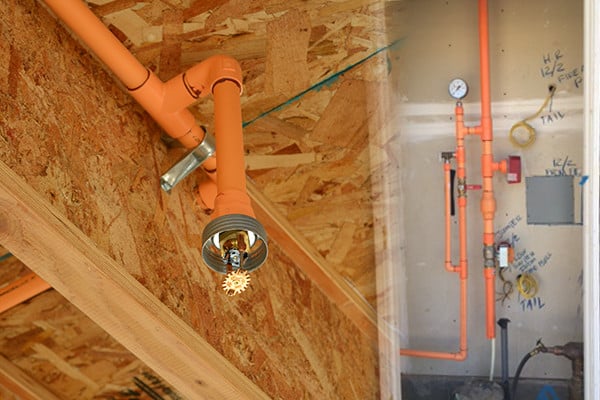
Elevated tanks use gravity to move the water, and they are uncommon in residential systems. Pressure tanks use a source of pressurized gas (like nitrogen) to hit flow requirements and may be an option in a setting with an unreliable power grid. The majority of tank-fed systems and systems relying on insufficiently pressurized municipal water supply will utilize an electric pump to move the water. While the exact size of a tank will vary depending on the size of a house and its flow requirements, “most stored water systems will need less than 300 gal (1136 L) of stored water to satisfy the 10-minute demand.”
If a tank is necessary, this typically means the homeowner will install a standalone system rather than a multipurpose system. Homes that are only served by wells will likely use that water source with the aid of a pump, and well systems with sufficient pressure could service both multipurpose and standalone systems. It is also possible to use a separate tank if the home is served by a well.
When city water is the source, local regulations often require a water meter to measure water usage plus a backflow preventer, which is a one-way valve that prevents the standing water in a wet sprinkler system from making its way back into the potable water supply. Ultimately, each of these additional parts adds friction that reduces available pressure in the system. Thus, a fire sprinkler contractor must install larger water taps and meters (of at least 1”) to minimize this impact, and account for the presence of these devices in the hydraulic calculations for the system.
In addition, “some water utilities insist on separate taps and supply pipes from the water supply to the dwelling unit for fire sprinkler systems … due to concerns about shutting off the water supply for nonpayment of bills and the desire not to shut off fire protection if this ever occurs.” Check your local requirements!
NFPA strongly discourages governments from requiring separate supply lines. The organization cites the potential health and safety issues of shutting off any water supply — whether it serves a fire sprinkler or regular plumbing — plus the fact that separate supply lines vastly increase the cost of sprinkler installations, which reduces the number of systems and lives and properties saved.
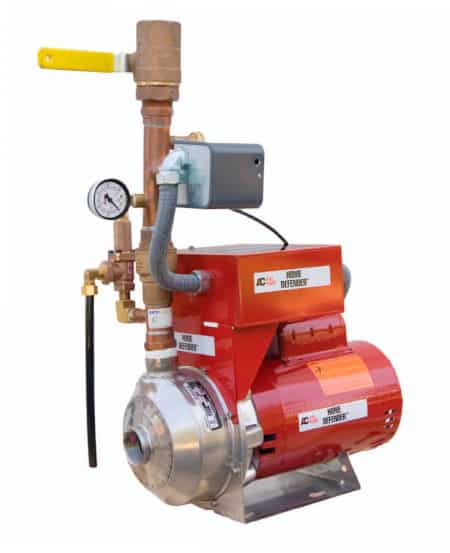
Special considerations for home fire sprinkler pumps
Adding a pump adds complexity to a system. NFPA outlines several requirements when a pump that only pressurizes the water supply for the sprinklers is used:
From the 2022 edition of NFPA 13D
6.2.1 Where a pump is the source of pressure for the water supply for a fire sprinkler system but is not a portion of the domestic water system, the following shall be met:
(1) A test connection shall be provided downstream of the pump that creates a flow of water equal to the smallest sprinkler K-factor on the system.
(2) Pump motors using ac power shall be rated for 240 V and wired in accordance with the NEC (NFPA 70). [Note: This requirement covers pumps used in all types of systems, regardless of water source]
(3) Any disconnecting means for the pump shall be approved.
(4) The pump shall be located not less than 11⁄2 in. off the floor.
A test connection is an outlet (like a garden hose spigot) that allows the homeowner to test whether the water flows to the sprinkler system, as well as test a water-flow alarm if one is present. It stimulates the flow to a single sprinkler head, and “the smallest sprinkler K-factor” essentially means “the smallest rate of discharge for a sprinkler.”
Having a test connection is specified in the pump requirements because it basically verifies that the pump is doing its job. If a pump is used in conjunction with a tank in a standalone system, the test connection should ideally be designed to return the test water to the tank, so it stays full.
NFPA states that the 240-V requirement for a pump is in place because “experience has shown that 240-V rated pumps reduce the likelihood for the pump to draw excess amperage, which can result in the tripping of associated circuit breakers in the electrical panel and cause the pump not to operate.” This electrical requirement applies to all pumps, not just those used in standalone systems.
Finally, keeping the pump 1.5” off the floor is simply intended to make sure standing water can’t short-circuit or otherwise interfere with the pump. There are a variety of manufacturers that make relatively inexpensive pumps meeting these standards.
Sprinkler heads in residential sprinkler systems
The major orientation classifications of home fire sprinkler heads govern where the heads are placed and how they operate: pendent, upright, and sidewall. Within those categories, a sprinkler can be concealed or exposed (with recessed or non-recessed options), and usually have an ordinary or intermediate temperature rating.
There are other variations of sprinkler heads, like sprinklers that are required for “dry” systems or other varieties for special locations like saunas, steam rooms, and mechanical closets — but the overwhelming majority of residential fire sprinkler systems are “wet” (water is always in the pipe) and have pendent and/or sidewall heads with activation temperature around 155F (68C), and any special areas often do not require sprinkler coverage in NFPA 13D.
Here are the essential orientations and types of home fire sprinklers:
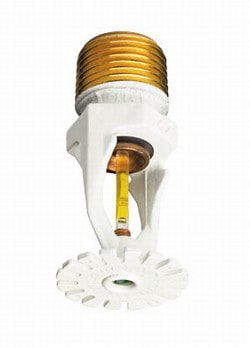
Pendent fire sprinkler heads hang from the underside of the pipe that delivers the water. These are installed in ceilings — either exposed or recessed a bit with an escutcheon — and have a deflector that sprays the water downward in a circular pattern.
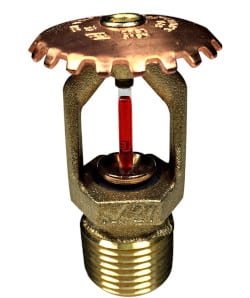
Upright sprinkler heads sit upright from the supply pipe. These are more often seen in commercial applications, though they can be installed in a home. They are “used mostly in places where obstructions may block water spray during a fire, and their height allows them to aim water around possible obstacles.” They can also provide coverage in spaces where there is no place to run the pipe up the walls or in the ceilings. For example, you might see them in unfinished-loft-style homes.
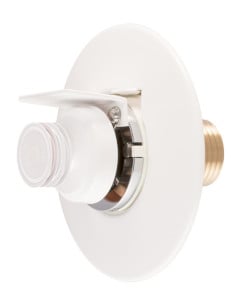
Sidewall sprinklers, as you’ve probably guessed, jut from a vertically-running pipe and the sides of walls. They have a deflector that sprays the water in a crescent pattern at an angle. Sidewalls are installed in areas where they may be a better option than pendent sprinklers. For example, they may be used on the uppermost floors of a house to avoid having to run pipes in an attic subject to freezing temperatures, or in other rooms where pipes can’t fit into the ceiling.
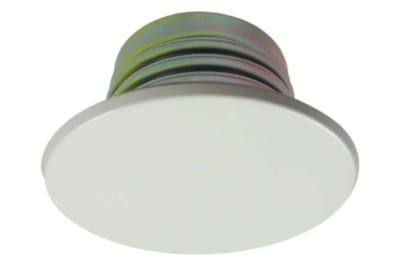
Concealed pendent or sidewall sprinklers are covered by an aesthetically pleasing cover plate that is sensitive to high temperatures. Once the plate senses a certain temperature, it drops away and the sprinkler head is exposed. An essential warning when using concealed sprinklers is to never paint over the cover plates, as dried paint over the seams will cause them to fail.
Temperature ratings are also important factors:
- Sprinkler heads with an ordinary temperature rating deploy when the temperature around the trigger reaches 135°F to 170°F (57°C to 77°C). These are the go-to rating in most installations.
- Sprinklers with an intermediate temperature rating deploy when the temperature reaches 175°F to 225°F (79°C to 107°C). They may be used for sprinklers close to consistent heat sources.
There are sprinklers with a higher temperature rating that could be used in a residential system, but doing so is unusual, given the high upper limit of the temperature ranges above. NFPA 13D specifies the use of either ordinary or intermediate temperature-rated sprinklers in rooms “where maximum ambient ceiling temperatures do not exceed 100°F (38°C)” (7.5.6.1), and only permits the use of intermediate-rated sprinklers in rooms “where maximum ambient ceiling temperatures are between 101°F and 150°F (38°C and 65°C)” (7.5.6.2), with exceptions for sprinklers exposed to specific heat sources, like saunas and “closets containing ventless clothes dryers” (7.5.6.3).
Why would an installer use an intermediate temperature-rated sprinkler in a normal room? To adjust for certain heat sources, according to NFPA:
- Sprinklers under glass or plastic skylights exposed to direct rays of the sun
- Sprinklers in an unventilated concealed space under an uninsulated roof or in an unventilated attic
- Sprinklers installed near specific heat sources [such as fireplaces, kitchen ranges, furnaces, etc.]
There is also the option to move ordinary temperature-rated sprinkler heads farther away from any heat sources in a room, and NFPA 13D outlines minimum distances from these hot spots to avoid an accidental discharge.
How many fire sprinkler heads are necessary?
NFPA 13D’s overall guidance recommends “sprinklering of all areas in a dwelling” but does not require it. Essentially, sprinklers only need to cover rooms of a certain size that are considered living areas. Standard sprinklers cover a 12’ x 12’ area and extended coverage sprinklers cover a 20’ x 20’ area, and each head must generally be placed at least 8’ apart; thus, many rooms will only need one or two sprinkler heads.
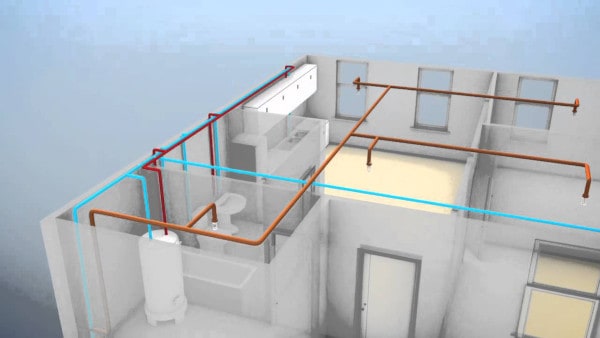
Sections of a home that can be excluded from coverage according to NFPA standards include small bathrooms, garages, closets, and other storage spaces. The reason? “The historical loss data associated with fires in residential properties serve as a reasonable justification to permit the omission of sprinklers in spaces where a low incidence of fire deaths has occurred, thus lowering costs.”
From the 2022 Edition of NFPA 13D
8.3.2 Sprinklers shall not be required in bathrooms of 55 ft2 (5.1 m2) and less.
8.3.3 Sprinklers shall not be required in clothes closets, linen closets, and pantries that meet all of the following conditions:
(1) The area of the space does not exceed 24 ft2 (2.2 m2).
(2) The walls and ceilings are surfaced with noncombustible or limited-combustible materials as defined in NFPA 220.8.3.4* Sprinklers shall not be required in garages, open attached porches and balconies, carports, and similar structures.
8.3.5 Sprinklers shall not be required in attics with or without storage, penthouse equipment rooms, elevator machine rooms, concealed spaces dedicated exclusively to and containing only dwelling unit ventilation equipment, floor/ceiling spaces, vertical chases, elevator shafts, crawl spaces, and other concealed spaces that are not used or intended for living purposes. [Note: with exceptions for spaces with “fuel-fired equipment.”]
8.3.6 Sprinklers shall not be required in unheated enclosures at the building at entrances/exits as long as the dwelling unit has another entrance/exit.
8.3.7 Sprinklers shall not be required for ceiling pockets that meet the following conditions:
(1) The total volume of all unprotected ceiling pockets in a compartment does not exceed 100 ft3 (2.8 m3).
(2) The entire floor under the unprotected ceiling pocket is protected by sidewall or pendent sprinklers at the lower ceiling elevation.
(3)* The interior finish of the unprotected ceiling pocket excluding decorative treatments is noncombustible or limited-combustible material.
(4) Skylights not exceeding 32 ft2 (3 m2) shall be permitted to have a plastic cover.8.3.8 Sprinklers shall not be required in closets in garages and exterior closets (regardless of size) located on exterior balconies, exterior breezeways/corridors, or accessed from outdoors where the closet does not have doors or unprotected penetrations directly into the dwelling unit.
8.3.9 Sprinklers shall be installed in any closet used for heating and/or air-conditioning equipment, washers and/or dryers, or water heaters except as allowed by 8.3.8.
Despite those guidelines, your local government may require additional coverage in some or all of these areas. For example, California requires sprinkler coverage of attached garages. Be sure to check your local codes and hire a knowledgeable installer who has experience navigating them.
NFPA 13D specs are also intended to avoid accidental discharges from normal heat sources, the deployment of one sprinkler blocking the deployment of another by cooling it, any obstructions (like ceiling fans and light fixtures), and large “shadow areas,” which are “sections of the floor area obstructed from sprinkler discharge, which will remain relatively dry.” Again, experienced designers and installers know these issues.
To be continued: a guide to installing residential fire sprinklers
In the next installment of this series, we round out the major system components of a home sprinkler system, exploring the pipe options that can be used in standalone and multipurpose systems.
View residential fire sprinklers from QRFS!
If you have any other questions about residential fire sprinklers or need help finding an item, add a comment below, give us a call at 888.361.6662, or fill out our contact form.
This blog was originally posted at QRFS.com/blog. If this article helped you, check us out at Facebook.com/QuickResponseFireSupply or on Twitter @QuickResponseFS.


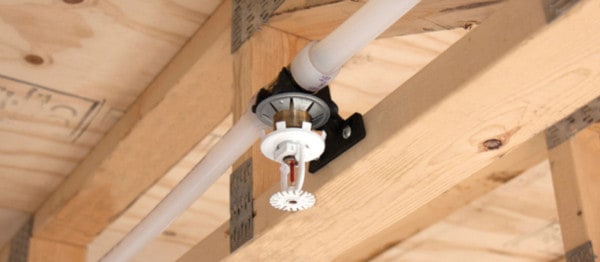
I live in a Lennar built home for 3 years. Do we need to worry about any type of maintenance on the fire sprinklers?
Joseph, thank you for reaching out. As a homeowner, you are responsible for the maintenance of the residential fire sprinkler system. Thankfully, maintain home fire sprinklers is fairly simple. We have an article with all the dos and don’ts of residential fire sprinkler maintenance. We hope this helps!
Is any especial fire sprinkler head allowed to be inside of a water heater closet? If any head allowed is there any code that tells you how far the head needs to be from the water heater?
Andres, the two main pieces of code from NFPA 13 are “8.3.8 Sprinklers shall not be required in closets in garages and exterior closets (regardless of size) located on exterior balconies, exterior breezeways/corridors, or accessed from outdoors where the closet does not have doors or unprotected penetrations directly into the dwelling unit.” and “8.3.9 Sprinklers shall be installed in any closet used for heating and/or air-conditioning equipment, washers and/or dryers, or water heaters except as allowed by 8.3.8.”
You should check with your local authority having jurisdiction or fire marshal to determine if there are any additional guidelines. Hope this helps!
Although sprinklers are not required in garages, I have a situation where the ceiling of the garage is the floor of the kitchen. We spray foam insulated the garage ceiling because of the radiant heat in the kitchen floor. It is impossible to effectively sheetrock over the spray foam but it needs a 1 hour flame rated covering. Will sprinklers take the place of or modify that requirement?
Thanks
David, you should work with your local authority having jurisdiction to determine if sprinklers modify that requirement.
We are finishing off an attic in Buffalo NY. NY requires a limited area sprinkler system for attics that are restored for living. We have used closed cell spray foam on the entire roof area and walls, filling the cavities. We have installed 5/8″ fire rated sheet rock on the entire ceiling and 1/2″ on the walls. There is a bathroom built in the attic that has a square footage of 46 square feet, including the shower and vanity area. The room has 46 ” knee walls, that seal off the unuseable areas of the attic to make one room that is 11 feet wide by 29 feet long. There are two hard wired smoke/CO2 detectors that are tied into other hard wired units on the second floor, main floor, and basement. All with battery backup. The house is on a monitoring alarm system. The pitch on the ceiling in the attic is an 8/12 pitch.
How many sprinkler heads should be required for this area if a system is being set up for protection of life only and not protection of property?
Dawayne, thank you for reaching out. To determine the number of sprinkler heads needed, you will want to work with both a licensed fire sprinkler contractor and your local authority having jurisdiction. A licensed fire sprinkler contractor can help you with the design of the system and your local authority having jurisdiction will ensure local fire code regulations are met.
Please call me.
John, thank you for reaching out. We will have someone from our QRFS Support Team reach out. You can always reach us at 888-361-6662 or support@qrfs.com.
What percentage of the full load amps are used to calculate the fuse size on a residential fire pump?
James, thanks for reaching out. For code questions like this, we recommend submitting your question through QRFS Ask A Pro. Click the link to submit your question with some information about your building or system, and a fire protection professional will provide a detailed answer based on standards and codes. Our pros include AHJs, contractors, engineers, and code experts with 150+ years of combined experience!
Hi, I have some vertical shafts (pipes) where is needed a sprinkler at the bottom (NFPA 13). So, Is there another document where specificity the better way to install a sprinkler there.
Pietro — NFPA 13 is the definitive installation standard for commercial installations. NFPA 13D is the installation standard for residential installations. There are no alternative documents that specify the rules for water-based sprinkler installations. Best of luck!
My city water source’s pressure is over 120 psi., so i utilize a pressure reducer to lower it to 75 psi inside of the house to protect appliances and other fixtures. If I’m to install a fire sprinkler system for a small structure on my property (think pool house) must I create a dedicated water supply that is placed in front of the pressure reducer so that I can get the proper pressure required to adequately supply the sprinkler system? My supply from the city is 3/4″ pipe, do I need to increase the supply pipe to 1″ or higher as I come off the 3/4″ city supply line? Another option would be to access supply via a 1/2″ hose bib, but I feel this is not adequate supply.
John — These are complex questions best addressed by a qualified system designer. There are water supply options one can discuss with you, whether it involves a pressure reducing valve, a separate water supply (such as a tank), or something else. We suggest you contact a fire sprinkler pro in your area. Thanks for reading!